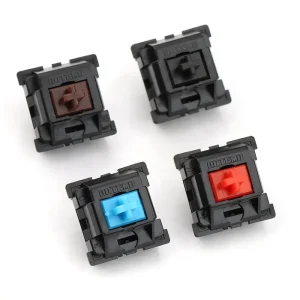Keyboard Switch
● Unit Price:$0.10~$0.50
● OEM & ODM
● Branded connectors or Branded replacements
● Many models are being uploaded, contact us for product catalog
Mechanical keyboards are all the rage. They come in all sorts of shapes and sizes, wired or wireless, and of course, with and without fancy RGB lighting. But the most important factor to consider while buying a mechanical keyboard has to be the key switch. Choosing the right key switch can make a huge difference as opposed to a membrane-based keyboard. They are more reliable and offer a more personalized experience by offering varied feedback and travel time depending on which one you choose. Mechanical keyboard switches also tend to have a much better shelf life lasting millions of keystrokes.
Mechanical keyboard switches are broadly available in three categories. Depending on their characteristics, they are either linear, tactile, or clicky.
SZGOZIE’s Each key on a mechanical keyboard hides an actual physical switch under it, unlike the squishy rubber membrane you’d find on most keyboards. Typing on these mechanical switches is a very different experience from typing on regular ones. The keys have more travel, and are much more tactile; you don’t have to press the keys all the way down to get them to register, which makes typing easier on the fingers; and of course, mechanical keyboards have their own unique sound. They sound like a keyboard.
Mechanical keyboards differ from traditional membrane keyboards in that they use physical switches under the keycaps, meaning each key press can be felt and heard. They are ideal for typing as they optimize the feel and sound of your keyboard.
Mechanical keyboard switch is widely used in computer keyboards and cash registers.
Product List
USB Connector
Wafer Connector
Terminal Block
Pin Header
RJ45/RJ11
FFC, FPC (Flat Flex) Connectors
D-Shaped Connectors
Koaxial RF-Connector
Housing connector
Wire-to-Board Connector
Board-to-Board Connector
CCTV Accessories connector
Button Battery Holder
18650 Battery Holder
Energy Storage Connector
Solar Connector
AMP Car Connector
Circular Din Connector
Memory Card Connector
XLR Connectors
Waterproof connector
Frequently bought together
Based on their characteristics, there are basically three types of switches: Linear switches, tactile switches and clicky switches.
Linear switches are the simplest ones. They feel the same from the moment you start pressing the key until bottoming out. There is no tactile feedback or noise when hitting the actuation point (the point where the keypress gets registered – usually somewhere in the middle). So, most of the time, you will probably bottom out on each key press.
Tactile switches provide tactile feedback, when hitting the actuation point. As you press the key down, you will notice a small bump, which lets you know, that your key press got successfully registered.
Clicky switches provide an additional click sound, when hitting the actuation point. The main advantage of tactile and clicky switches is that you don’t have to push the key all the way down. You can release the key immediately after you receive the feedback.
Each key on a mechanical keyboard hides an actual physical switch under it, unlike the squishy rubber membrane you’d find on most keyboards. Typing on these mechanical switches is a very different experience from typing on regular ones. The keys have more travel, and are much more tactile; you don’t have to press the keys all the way down to get them to register, which makes typing easier on the fingers; and of course, mechanical keyboards have their own unique sound. They sound like a keyboard.











